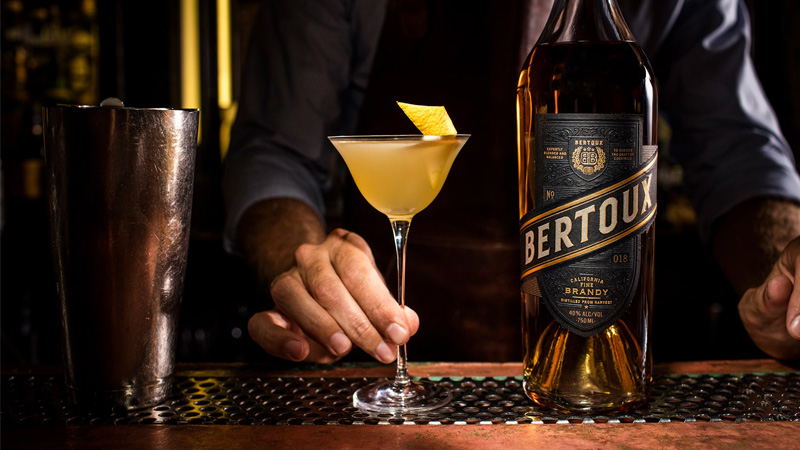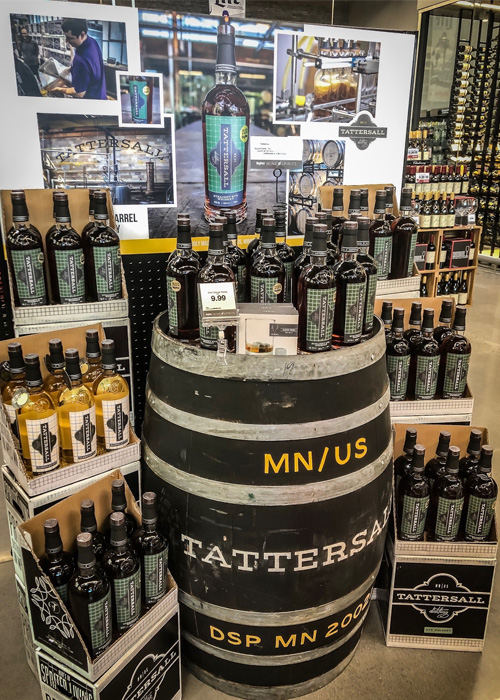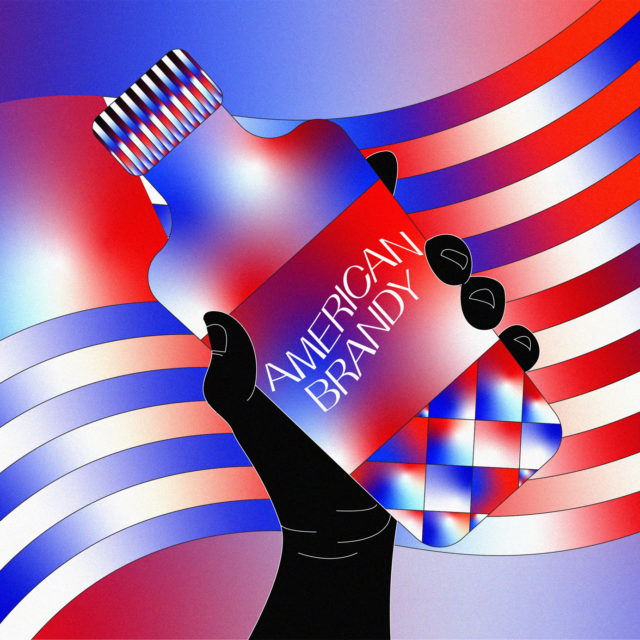While bourbon enjoys the status of America’s native spirit, brandy is the nation’s O.G. in terms of pure distilling history. As early as the mid-18th century, European settlers on both coasts were cranking out fruit distillates for commercial consumption, with grapes leading the way on the West Coast and orchard fruits taking center stage in the East.
Like much of American drinking culture, the nation’s brandy industry eventually suffered huge setbacks during Prohibition. After repeal in 1933, brandy failed to bounce back. Whiskey was the more natural choice for distillers returning to the business, because it was quicker and cheaper to produce than brandy, and had slaked the thirst of American drinkers in the (not-so) surreptitious speakeasies during the “dry” years.
In recent decades, big-name brands like E&J, Paul Masson, Christian Brothers, and Korbel have ensured American brandy is not entirely forgotten. But these brands’ focus on lower-priced bottles left American brandy out in the cold during the rebirth of cocktail culture, and has kept it all but unmentioned in recent conversations of premiumization.
Only now, the needle is shifting.
Nationwide, craft producers are putting out super-premium brandies using a range of fruit bases, inspired as much by other brown spirits as they are by traditional production techniques. Hospitality professionals are joining the party with cocktail-friendly bottlings aimed at on-premise channels. At the same time, the nation’s major conglomerates have built on their lower-value propositions with luxury proprietary brands, and by scooping up craft producers.
The growing momentum has seen media outlets celebrate “surging sales” and even declare a “brandy renaissance.” But just how ripe is the market for another brown spirits revival?
The State of American Brandy
At first glance, the numbers don’t look good for the so-called renaissance. American brandy volumes declined 1.1 percent in 2019, and value dropped 0.9 percent, according to research firm IWSR. Yet these numbers alone don’t paint the full picture.
Amid last year’s overall decline, the super-premium segment grew 31 percent, per IWSR data, suggesting that something is indeed stirring within America’s oldest spirits category.
Such growth could signal increased interest in pricey domestic brandy. Then again, it could also be a byproduct of more distillers entering the mix. Either way, those involved in the industry are very much aware of the hurdles standing in the way of American brandy reclaiming its former glory. But that’s not stopping them from trying.

How Can American Brandy Break Out?
No conversation on American brandy is complete without mention of E. & J. Gallo. The world’s largest privately owned wine producer introduced its market-leading E&J Brandy in 1975. Gallo later took significant steps into the super-premium segment in 2017, launching the Argonaut label and acquiring Germain-Robin, a craft brand launched in the early 1980s by Cognac native Hubert Germain-Robin and American Ansley Coale. This month, Gallo opened the California Brandy House, a downtown Napa tasting room dedicated to luxury California brandy.
Britt West, Gallo’s vice president and general manager of spirits, is quietly confident about the prospect of an American brandy revival, but he’s also quick to recognize the challenges ahead. “Building spirits categories takes a long time in this country,” he says. “The ‘overnight success’ of luxury rum was really a 20-year journey. And that’s still very much how I think about brandy.”
Along its journey, West says, American brandy will need to build a critical mass of quality-focused producers and escape its reputation as a post-dinner digestif that should be sipped from a snifter. Only then can brandy stake a claim among the “pantheon of luxury brown spirits,” he says, and reclaim classic drinks that were usurped by bourbon and rye post-Prohibition — cocktails like the Sazerac and even the Old Fashioned (to some degree).
Indeed, the rise in craft cocktail culture is often cited as a factor in the current popularity of bourbon and rye, so it makes sense that luxury brandy producers would look for success using a similar approach. Gallo is not unique in realizing this.
Founded in 2014, Kentucky-based Copper & Kings American Brandy Company was acquired this year by Constellation Brands. The brand’s website devotes an entire database to cocktail recipes. Likewise, its social media channels showcase attractive “portrait mode” cocktail shots, alongside professionally produced recipe videos. Nowhere is there a suggestion of velvet robes or cigars.
The same is true on the website of California brandy Bertoux. Launched in 2018, the spirit was crafted with cocktails in mind. Leading NYC drinks professionals Jeff Bell (PDT) and Thomas Pastuszak (The NoMad) dialed into their respective bartending and sommelier experience to formulate the brandy’s final blend. Even the brand’s name — French for “Sidecar” — leans into the spirit’s historical use as a cocktail ingredient.
Yet Bell does not think sharing recipes and dialing into history are enough to cement the reputation of Bertoux, or any other brandy, as a quality cocktail ingredient. “If you have a good product, education is important,” he says.
It’s one thing telling drinkers that American brandy makes a wonderful Old Fashioned, but there’s so much more value in telling them why that’s so. After the launch, Bell and Pastuszak prioritized getting their bottles into the hands of the right people — in this case, New York’s leading bartenders and sommeliers.
Though a slow-paced form of education, having experienced drinks professionals communicate the brand’s message allows them to shape the narrative, Bell says. Ultimately, this helps define the category — and what it can become.

(Re-)Defining American Brandy
Shaping the narrative is perhaps the most important task for American brandy producers right now. Before selling consumers on its virtues, brands must first clearly define what American brandy is and why it’s unique.
“We’re not even in a renaissance of American brandy, it’s almost like there’s a completely new book being written,” Pastuszak says, citing the myriad styles that currently make up the category. While some producers are emulating the Cognac or Armagnac model, others are essentially making spirits that taste like whiskey, but are labeled as brandy, he adds.
Across the board, however, there is some agreement on the thread that binds the category beyond geographical ties: the ability to experiment.
“To quote one of our founders, Hubert Germain-Robin, ‘This is freedom brandy,’” explains David Warter, lead blender and distiller for Germain-Robin. “Unlike the constraints you have with Cognac, American distillers have more freedom in brandy-making when it comes to choosing the grape varieties to create original and distinctive styles and taste profiles.”
While Cognac producers are bound to Ugni Blanc, a high-yielding white variety that offers little character, Germain-Robin turns to Pinot Noir, Colombard, and Semillon to enhance the flavor and textural qualities of its spirits. Germain-Robin isn’t alone: California’s Charbay and Osocalis distilleries provide further compelling evidence that “non-traditional” varieties like Pinot Noir and Semillon are just as suited for distillation as they are high-quality wine making.
The scope isn’t limited to grapes, either — though per Alcohol and Tobacco Tax and Trade Bureau guidelines, when an American brandy is made with any other ingredient, the fruit must be listed on its label.
Across the nation, fruit brandies run the gamut from Laird’s Apple Brandy, produced by a family-owned New Jersey distiller for over two centuries, to the un-aged pear and raspberry brandies of California’s St. George Spirits.
Jon Kreidler, co-founder of Minnesota’s Tattersall Distilling, describes such diversity as another feather in American brandy’s cap. “A brandy producer in Minnesota is going to make a very different product than [one based] in Georgia,” he says. Much like wine, he adds, this speaks to the notion of terroir, and is something that will likely entice engaged spirits drinkers.
Among its portfolio of spirits, Tattersall makes apple brandy using organic fruit sourced from local orchards. For now, the brandy remains a “smaller part of the business” compared to its vodka and gin, Kreidler says. Like all the producers contacted for this piece, he’s quick to remind us that, despite its storied history, the modern American brandy category is still in its infancy. Significant growth of the category is simply going to take time, he explains, and for those who got in on the ground floor (and can afford to wait), this isn’t such a bad thing.
“The nice thing about our brandy,” Kreidler says, “is that if it isn’t selling quite like we think, we just keep it in barrel for longer and it’s only going to get better.”
This story is a part of VP Pro, our free platform and newsletter for drinks industry professionals, covering wine, beer, liquor, and beyond. Sign up for VP Pro now!
